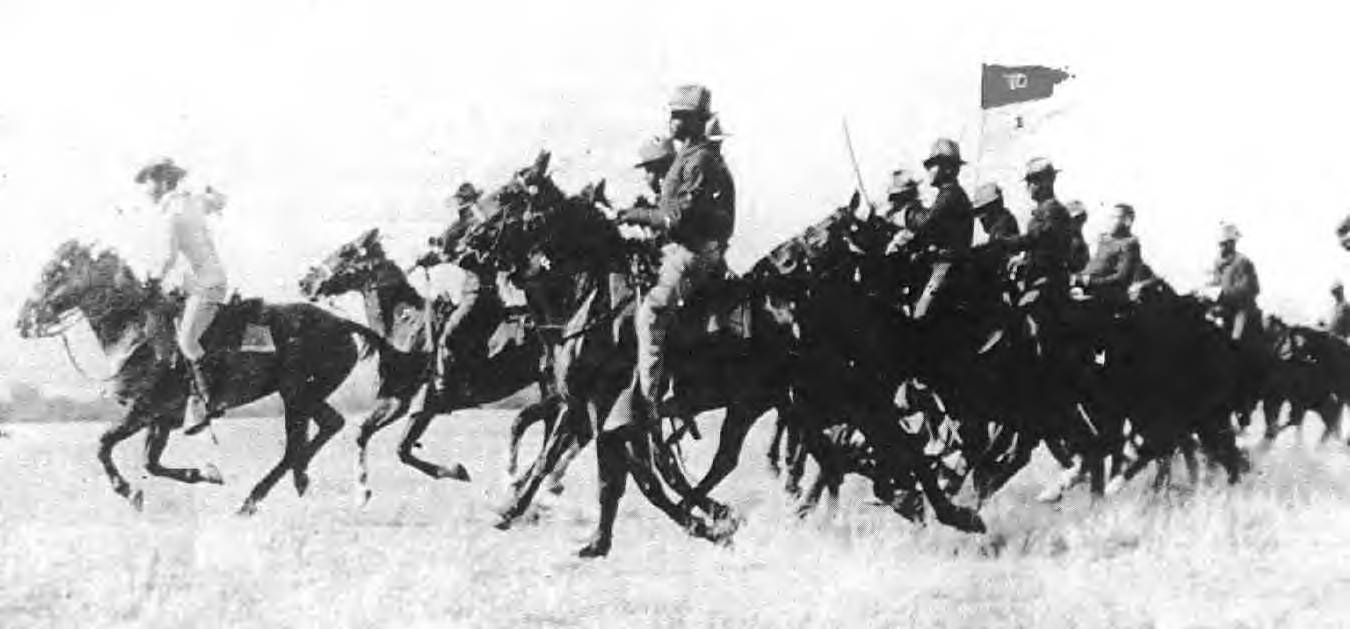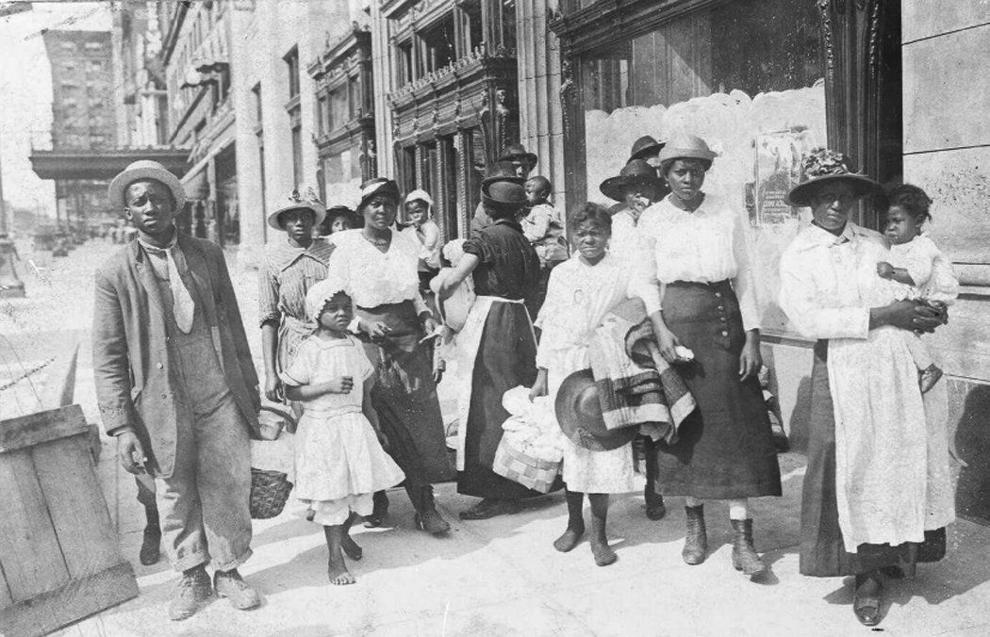| Black Panthers:
Race in America, Part Three
By Mike Bennighof, Ph.D.
January 2023
 There was a Buffalo Soldier There was a Buffalo Soldier
In the heart of America
Stolen from Africa, brought to America
Fighting on arrival, fighting for survival
- Bob Marley
Despite the lynchings and the widespread denial of their civil rights, Black soldiers fought for their country in 1898 when the United States went to war with Spain. The four Black regular regiments reported for duty with the expeditionary force, and thousands of Black men enlisted in the volunteer units raised by states to supplement the regulars. Eight states included segregated Black units in their contingents, and Ohio managed to entice the Regular Army’s only commissioned Black line officer, 1st Lt. Charles Young, into accepting command of its Black battalion (the Regular Army also had four Black chaplains who held commissions). Most of the Black state units also had Black officers; only Alabama’s contribution, the 3rd Alabama Volunteer Infantry, had only white officers.
The four regiments of Buffalo Soldiers fought exceptionally well in Cuba, and six Congressional Medals of Honor were awarded to their men. The two cavalry regiments played a crucial role in saving Teddy Roosevelt’s “Rough Riders” from their own stupidity in the Battle of San Juan Hill.
The Volunteer Army sought to raise ten so-called “Immune Regiments” of men who had recovered from yellow fever, or at least were used to hot and humid climates. A popular notion at the time – contrary to medical reality – held that people of African descent enjoyed a natural immunity to the disease. Four of the Immune Regiments (numbered 7th through 10th U.S. Volunteer Infantry) would be raised from Black volunteers, with Black lieutenants but white company commanders and staff officers.
The U.S. Army had only commissioned eight African-Americans since the end of the Civil War – three line officers and five chaplains. The policy of commissioning 100 Black men for these regiments (24 infantry lieutenants and one chaplain for each regiment) drew immediate criticism. “The presence of shoulder-strapped Negroes in our army,” the Richmond Dispatch thundered, “would be a constant source of embarrassment and weakness.”

Buffalo Soldiers prepare for war. Camp Wikoff, New York, 1898.
The soldiers thought little more of their racist fellow citizens. “We arrived in Kansas City, Mo., the gateway to America’s hell,” a veteran of the 7th USVI recalled later, “and were unkindly and sneeringly received . . . these black boys, heroes of our country, were not allowed to stand at the counters of restaurants and eat a sandwich and drink a cup of coffee, while white soldiers were welcomed and invited to sit down and eat free of cost.”
None of the Immune regiments made it to the combat zone, one arrived after the fighting had ended and spent a few months on occupation duty. Two of the state regiments (8th Illinois and 23rd Kansas) joined them there; one Black company of Massachusetts volunteers saw service on Puerto Rico as well. The Immune regiments were not; between them they lost 241 men and seven officers to tropical diseases.
Undeterred, the Army raised 25 new Volunteer regiments for the Philippine War that broke out immediately after American annexation of the islands. Two of those, the 48th and 49th, were segregated Black units but this time all company commanders were Black captains, most of them veterans of the Immune regiments. Three of the four Regular Army regiments of Buffalo Soldiers served there as well.
The American regiments mustering for service in Cuba and Puerto Rico departed from ports in Florida, chiefly Tampa, and usually mobilized at Army posts in the South. Two Black troopers from the 10th Cavalry were murdered in Tampa, where locals put a bounty on every Black soldier killed. Private James Nealy of the 24th Infantry was shot and killed by a drugstore clerk in Hampton, Georgia after attempting to purchase soda water at a whites-only counter.
Perhaps not surprisingly, the Black population at large showed little support for the Spanish-American War and even less for the Philippine War. They did not expect the United States to follow through on its pledges to secure the independence of the former Spanish colonies, and if they did, expected that the islands’ black and brown populations would have little say in their own governance.
In 1903, Congress passed the Militia Act to organize the various state militias into a National Guard. Many states formed segregated units of Black soldiers, with New York and Illinois each fielding a complete infantry regiment. These units included Black officers, though some posts still went to white men.
As Jim Crow laws grew ever more repressive in the early years of the 20th Century, the U.S. Army continued to field the same four Colored regiments that had been established after the Civil War. They again saw duty along the border with Mexico, and in 1906 a company of the 25th Infantry Regiment stationed just outside Brownsville, Texas was accused in the shooting death of a local bartender. Despite a lack of evidence, an entire company received dishonorable discharges, and President Theodore Roosevelt refused to intervene. These were overturned in 1992, by which time only one of the 157 was still alive.

The 10th Cavalry rides after Pancho Villa, 1916.
Three of the four regiments of Buffalo Soldiers participated in the 1916 invasion of Mexico commanded by “Black Jack” Pershing. Maj. Charles Young of the 10th Cavalry, the only Black West Point graduate on active duty (and third African American to complete the U.S. Military Academy), led his squadron in a successful charge against Villista troops in March and helped defeat Mexican federal soldiers in April. But troopers of the 10th Cavalry were defeated at the Battle of Carrizal in June 1916, which marked an end to active operations by Pershing’s force. “Having dashed into Mexico with the intention of eating the Mexicans raw,” Black Jack wrote later, “we turned back at the first repulse and are now sneaking home under cover, like a whipped cur with its tail between its legs.” But the public attention catapulted Black Jack into command of the next American expeditionary force, a much larger operation.
The United States declared war on Imperial Germany in April 1917, and began to mobilize an intended army of one million men for service in Europe. Workers at an aluminum plant in East St. Louis, Illinois, almost all of them white, took advantage of the resulting labor shortage to strike for higher wages. The company responded by hiring Blacks – many of them brought from Louisiana to work in jobs the union had denied to African-Americans – to replace them. The strikers met on 28 May, where rumors spread that some of the Black workers had had sex with white women. A crowd boiled out of the meeting and attacked randomly-selected Black people, but the situation seemed to calm afterwards.
On 1 July a car filled with white men roared through a Black neighborhood as the occupants blazed away at Black people on the street. When another carload of white men entered the neighborhood, the residents were ready and opened fire first, killing two police detectives. On the next day, white mobs attacked. They beat and shot Black people of all ages and genders, they set buildings aflame and shot down people trying to escape, they beat Black children to death, they lynched several Black men, and they beheaded at least one. People fled across the Eads Bridge into St. Louis, others tried to swim the Mississippi and drowned, and at least a few made it across on makeshift rafts. When a white unit of the Illinois National Guard arrived to restore order, witnesses testified later that they joined in the assault.
Up to 200 African-Americans died during the white rampage. State and city officials termed it a “race riot,” an important distinction – under most insurance policies, the insurer would not have to pay for damage or destruction inflicted during a “riot.” A state investigation later led to the conviction of 10 whites and 25 Blacks on charges ranging from inciting a riot to murder. White Congressman Leonidas C. Dyer of St. Louis asked President Woodrow Wilson to initiate a federal investigation; Wilson did nothing, citing a lack of evidence.

This was only a prelude. When they have finished burning books, they will end by burning people - Heinrich Heine.
A white mob has torched the East St. Louis library; homes and businesses burn in the background. St. Louis Dispatch, 2 July 1917.

This was only a prelude. American refugees flee the slaughter in East St. Louis. St. Louis Disptach, 2 July 1917.
While Americans murdered other Americans, they continued to mobilize for war. As part of the response to the huge increase in American military manpower, the 24th Infantry’s Third Battalion moved from Columbus, New Mexico to Houston, Texas in August to provide security for the newly-established Camp Logan, then under construction. Several incidents of white police beating Black soldiers and Black civilians, including women, enraged the troops. When rumors spread of a white mob marching on Camp Logan, Sgt. Vida Henry organized a group of about 150 Black soldiers who seized rifles and ammunition and marched on Houston.
Along the way they fired at houses and automobiles, seeking Houston police officers to kill. After they mistakenly shot and killed Illinois National Guard Capt. Joseph Mattes, thinking him a Houston police officer, the group broke up and Henry apparently shot himself. Afterwards, a white mob may have abused his corpse. In all the mutineers killed 11 civilians and five policemen, while four soldiers were killed. Afterwards 19 soldiers were hanged and 41 sentenced to life in prison.
A year after the East St. Louis and Houston incidents, Congressman Dyer introduced the Dyer Anti-Lynching Bill in Congress. It repeatedly failed to garner enough support to pass, as did other similar bills introduced over the decades that followed. As of this writing (July 2021) the U.S. Congress has never passed an anti-lynching bill. Opponents claim that since lynching is already illegal, the bill is mostly symbolic. While there’s some truth to that, the refusal to pass it is a damning symbol all its own.
The full series is here:
• Race in America: Founded on Slavery
• Race in America: Civil War
• Race in America: Jim Crow
• Race in America: The Black Doughboys, Part One
• Race in America: The Black Doughboys, Part Two
• Race in America: Red Summer
• Race in America: Tulsa
• Race in America: Klan Scam
• Race in America: Strange Fruit
• Race in America: Canada’s Shame
• Race in America: They Said No
You can order Black Panthers right here.
You will need Panzer Grenadier: Elsenborn Ridge to play Black Panthers.
You can order them together for one low price right here.
Sign up for our newsletter right here. Your info will never be sold or transferred; we'll just use it to update you on new games and new offers.
Mike Bennighof is president of Avalanche Press and holds a doctorate in history from Emory University. A Fulbright Scholar and NASA Journalist in Space finalist, he has published an unknowable number of books, games and articles on historical subjects.
He lives in Birmingham, Alabama with his wife and three children; he misses his dog, Leopold.
Want to keep Daily Content free of third-party ads? You can send us some love (and cash) through this link right here. |
